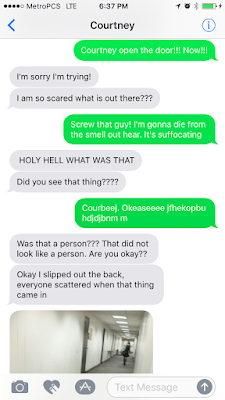Courtney:
In developing the narrative of this project, we knew that we wanted to construct a story based on some of the outrageous dreams that we were hearing from classmates. One idea that came to mind was a zombie apocalypse-type story. We decided to have it take place in a familiar location, the HFAC. We mapped out a general circumstance in which our narrative could take place, but we did not want the specific texting to seem too contrived, so we left the details up to improvise as we began texting each other back and forth. We felt that this spontaneity would inspire more creativity in the details, even though we’d already planned out the beginning, middle, and end. Because the characters in the narrative are in two different locations of the same building with the same event happening, the audience gets two different perspectives of this zombie-attack event: one from inside the building in the Nelke The other from outside, travelling towards the HFAC and eventually being outside in the halls being chased and subsequently “turned” by the undead. The narrative leaves the audience with a feeling of mystery, as they don’t get all the details of what the scene is simply because the characters themselves aren’t positive as to what exactly is happening.
Billy:
In crafting the apocalyptic zombie narrative, Courtney and I explored many avenues in hopes of achieving something unique and intriguing. It’s no question that the story of a zombie takeover has been so beaten and bloodied that it is difficult to create new and exciting media within that medium, at least to those outside of the faithful fan base. Something that struck me was how the Walking Dead, which is definitely new and exciting for this medium, used the concept of recurring characters returning as zombies. They also seemed to normalize the existence of the zombies, which allowed the audience to focus on the development of the characters. The intimacy and the vulnerability this created was something that I attempted to pursue in the text narrative from my perspective. It was difficult. I wish that I had been more patient and waited for replies from Courtney. In my opinion, there are too many 2-3 text spurts between the two of us. It could have been interesting to limit that and focus on slowly developing the narrative imbued with fresh ideas and perspectives from the both of us. I wanted to recreate a story similar to the kidnapping story we read on the app, which engaged the audience. I'd hoped to do this without too many:“Why are they texting right now!” moments experienced by the reader. As we discussed in class, I thought the limiting nature of this medium actually enhanced our story. If you pay careful attention to the textual cues given by Courtney and I, this intriguing narrative begins to take shape. This really helps to draw the reader into the narrative and use their own imagination to derive meaning and mood from the action occurring. I really enjoyed this assignment and working with Courtney as we attempted to bring this creation from the graveyard of ideas to life.



















